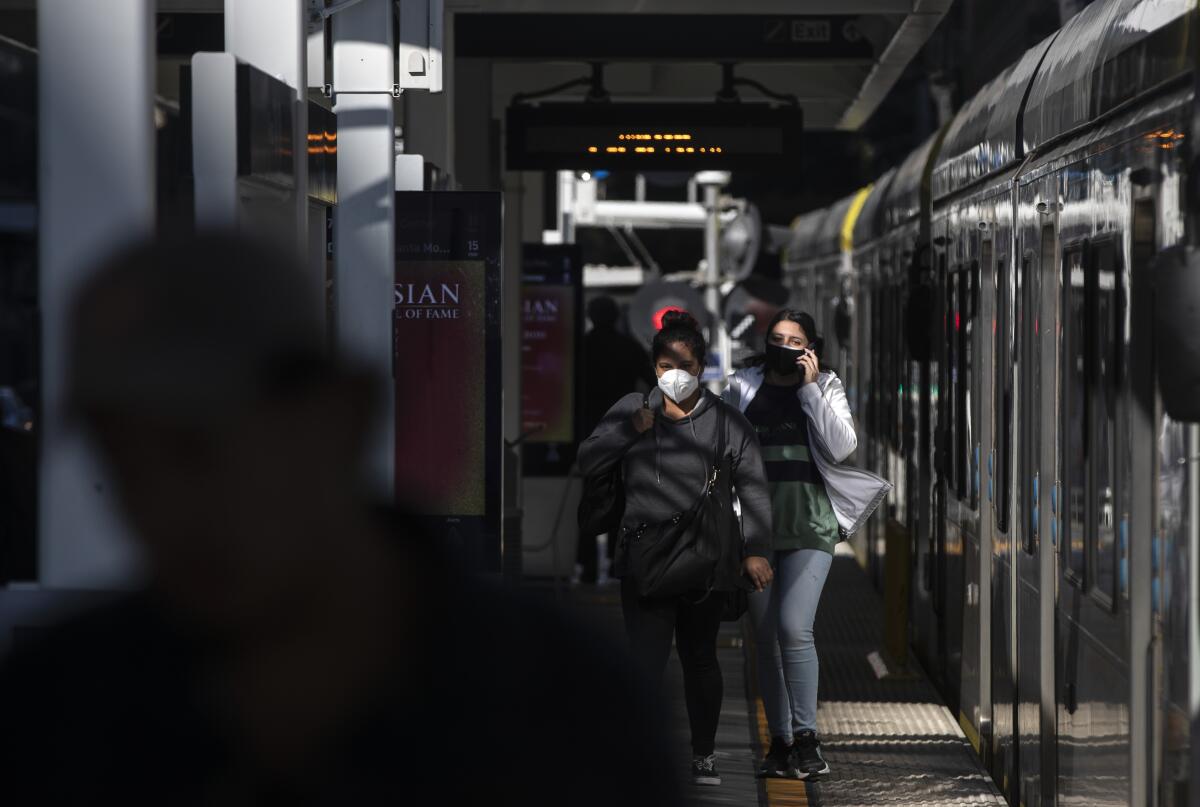L.A. Metro officials plan to boost ridership to pre-pandemic levels

- Share via
With the threat of COVID-19 receding, the Los Angeles County Metropolitan Transportation Authority plans to focus on boosting ridership levels that fell 70% during the pandemic and expanding transit service to low-income communities, according to top transit officials at the agency’s annual State of the Agency event.
For the first time in its 28-year history, the agency will be led by two women: Los Angeles County Supervisor Hilda Solis, who is Metro board chair, and Chief Executive Stephanie Wiggins. They said they will share responsibility for making the $8-billion agency more equitable and accessible after a devastating pandemic.
“The truth of the matter is that the pandemic exposed and exacerbated structural inequities across the county but also the country, from homelessness to housing to health disparities and more,” Solis said. “And we have to ask ourselves, what role can Metro play in addressing these issues and what can we do better?”
Solis, Wiggins and Los Angeles Mayor Eric Garcetti, the outgoing Metro board chair, pointed to the pain of the last year while also emphasizing the promise of the future.
“In my State of the City address this spring, I said the word that came to my mind that defines Los Angeles in 2021 is ‘becoming,’” Garcetti said. “This is a city that is becoming more just, becoming more equal, becoming more kind, becoming more itself ... and what we are and who we are in Los Angeles is encapsulated in this remarkable agency.”
Garcetti acknowledged the difficulties of a pandemic year in which Metro ridership dropped by 70% and the agency was forced to make deep cuts to its bus and rail services. Eleven Metro employees and two contractors died from the coronavirus, Garcetti said, as he asked for a moment of silence.
With the pandemic and last year’s racial reckoning demonstrating the need for reform in the agency, officials have the tall task of sustaining the current transit system while also implementing improvements. The agency is building or extending 15 bus lines.
“We’re having open heart surgery while we’re running a marathon,” Garcetti said. “We’re building an entire new system while we’re maintaining one.”
Wiggins and Solis said they share a vision for making the transit system more equitable and accessible for all Los Angeles County residents, including young people, low-income residents and homeless people.
Solis said she plans to help expand the transit system to its pre-pandemic levels, particularly in areas that serve low-income communities. As Metro purchases more property for its stations, Solis said she plans to ensure the agency builds new affordable housing units and supports small businesses.
“Metro has always done more than move residents to and from their destinations,” Solis said. “I commit to collaborating with local and community stakeholders, residents and businesses to develop projects that serve everyone and especially our most vulnerable.”
Metro will also soon have its first ever Youth Council to receive input from young people about the future of transit, Wiggins said.
She has ambitious plans for public transportation’s place in California.
“I want to make Metro the first choice for transportation that people think about,” Wiggins said. “I want Angelenos as they leave their homes to grab their keys and coffee in one hand and their cellphone and tap card in the other.”
Wiggins highlighted two recently implemented transit programs: the NextGen bus network, focused on faster and more accessible bus services, and Metro Micro, the agency’s ride-sharing service. She also emphasized plans to increase equity in the agency, including a Gender Action Plan and a community partnership strategy from the agency’s Office of Equity and Race.
More to Read
Sign up for Essential California
The most important California stories and recommendations in your inbox every morning.
You may occasionally receive promotional content from the Los Angeles Times.











